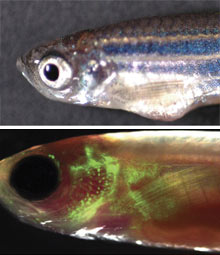기술동향
Provoking Our Inner Stem Cells
- 등록일2009-07-20
- 조회수10837
- 분류기술동향
-
자료발간일
2009-07-17
-
출처
Technology Review
- 원문링크
-
키워드
#Stem Cells#줄기세포#native stem cells
출처 : Technology Review
Provoking Our Inner Stem Cells
A startup aims to spur the body's native stem cells to heal disease.
By Lauren Gravitz
Fate Therapeutics, a startup based in La Jolla, CA, aims to harness the body's ability to heal itself by developing drugs that stimulate resident stem cells. Rather than developing cell transplants to replace diseased or damaged tissue, which is the focus of a great deal of stem-cell research, Fate is searching for molecules that can control the behavior of adult stem cells in different parts of the body. The two-year-old company began its first clinical trial in May of a novel molecule that could make cord-blood transplants more effective by enhancing the activity of the stem cells that create the blood and the immune system.
Fate Therapeutics, a startup based in La Jolla, CA, aims to harness the body's ability to heal itself by developing drugs that stimulate resident stem cells. Rather than developing cell transplants to replace diseased or damaged tissue, which is the focus of a great deal of stem-cell research, Fate is searching for molecules that can control the behavior of adult stem cells in different parts of the body. The two-year-old company began its first clinical trial in May of a novel molecule that could make cord-blood transplants more effective by enhancing the activity of the stem cells that create the blood and the immune system.

Caspar the Fish: By creating a transparent zebrafish, Harvard researcher Leonard Zon could watch fluorescently labeled hematopoietic stem cells from a donor fish repopulate the bone marrow of the recipient. The transparent mutant zebrafish, dubbed Caspar, provided a means for studying the effects of FT1050, an experimental drug now in clinical trials to boost the effectiveness of cord-blood transplants.
Credit: Cell Stem Cell
Credit: Cell Stem Cell
The human body is full of adult stem cells--small populations of tissue-specific stem cells that are capable only of developing into the cells of their resident tissue, and whose job is to help maintain and repair that tissue. While they lack the flexible fate of embryo-derived stem cells, adult stem cells come in a variety of flavors, including those capable of making liver cells and immune and blood cells, among others. Fate Therapeutics believes that, with a little pharmaceutical prompting, these cells can be nudged to repair tissue and organ systems, or even fight back against cancer.
"[Adult stem cells] can be induced to proliferate, they can be induced to differentiate into the cell type they were destined to become, or potentially even induced to become something they weren't destined for that might be therapeutically relevant," says Paul Grayson, Fate's president and CEO.
To better understand how to activate and command adult stem cells, Fate has focused much of its research on induced pluripotent stem (iPS) cells, adult cells that have been reprogrammed back to an embryonic state and have the same flexible developmental potential as embryonic stem cells. Rather than trying to use these iPS cells to treat disease, Fate is using them as a discovery tool to learn more about which pathways are important for activating or inhibiting stem-cell development.
Fate's first clinical trial focuses on a molecule known as FT1050. The molecule appears to stimulate proliferation of hematopoietic stem cells--which give rise to blood and immune cells--and helps guide them to the bone marrow. If successful, the drug could become an invaluable companion treatment to bone-marrow transplants and cord-blood transfusions used to treat cancer and blood diseases.
Treatment for leukemia or lymphoma, for example, kills off most of a patient's hematopoietic stem cells, and the best way to repopulate them is through bone marrow transplanted from a matched donor. When a bone-marrow donor match is unavailable, oncologists turn to umbilical-cord blood, which is rich in stem cells and requires only a partial tissue-type match. However, cord blood is also incredibly expensive, costing upwards of $30,000 or more per unit, and blood from a single cord is often insufficient to treat an adult.
"It becomes very difficult to find a unit large enough to sufficiently large enough for a full-grown adult," says Dennis Confer, chief medical officer of the National Marrow Donor Program. Physicians can sometimes use blood from two cords, but this is even more expensive and requires that both cord samples match the donor. "If someone could come up with an expansion strategy that was more cost-effective, that could gain wide acceptance," he says.
In an early-stage clinical trial, Fate Therapeutics is testing FT1050 in 12 patients who've undergone chemotherapy for lymphoma. The patients will each receive two units of cord blood: one that's been treated with the stem-cell-modulating drug, and another that's been left alone. The trial is primarily a safety study, but because the two units were harvested from two different newborns, researchers can use the genetic differences to track the cells and determine if FT1050-treated stem cells can more efficiently take hold and prosper in bone marrow.
Fate believes that multiple conditions can be treated this way, using small molecules to control adult stem-cell activity. The company is even pursuing the same strategy for cancer treatments, with the hope that they can disrupt the uncontrolled growth of cancer cells by forcing them into a more differentiated, less malignant state.
...................(계속)
☞ 자세한 내용은 내용바로가기 또는 첨부파일을 이용하시기 바랍니다.
관련정보
지식
동향

